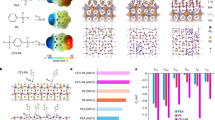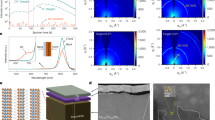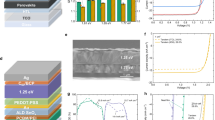Abstract
The fabrication of scalable all-perovskite tandem solar cells is considered an attractive route to commercialize perovskite photovoltaic modules1. However, the certified efficiency of 1-cm2-scale all-perovskite tandem solar cells lags behind their small-area (approximately 0.05-cm2) counterparts2,3. This performance deficit originates from inhomogeneity in wide-bandgap (WBG) perovskite solar cells (PSCs) at a large scale. The inhomogeneity is known to be introduced at the bottom interface and within the perovskite bulk itself4,5. Here we uncover another crucial source for the inhomogeneity—the top interface formed during the deposition of the electron transport layer (ETL; C60). Meanwhile, the poor ETL interface is also a notable limitation of device performance. We address this issue by introducing a mixture of 4-fluorophenethylamine (F-PEA) and 4-trifluoromethyl-phenylammonium (CF3-PA) to create a tailored 2D perovskite layer (TTDL), in which F-PEA forms a 2D perovskite at the surface, reducing contact losses and inhomogeneity, and CF3-PA enhances charge extraction and transport. As a result, we demonstrate a high open-circuit voltage (Voc) of 1.35 V and an efficiency of 20.5% in 1.77-eV WBG PSCs at a square-centimetre scale. By stacking with a narrow-bandgap (NBG) perovskite subcell, we report 1.05-cm2 all-perovskite tandem cells delivering 28.5% (certified 28.2%) efficiency, the highest reported so far. Our work showcases the importance of treating the top perovskite/ETL contact for upscaling PSCs.
This is a preview of subscription content, access via your institution
Access options
Access Nature and 54 other Nature Portfolio journals
Get Nature+, our best-value online-access subscription
27,99 € / 30 days
cancel any time
Subscribe to this journal
Receive 51 print issues and online access
199,00 € per year
only 3,90 € per issue
Buy this article
- Purchase on SpringerLink
- Instant access to full article PDF
Prices may be subject to local taxes which are calculated during checkout




Similar content being viewed by others
Data availability
All data are available in the main text or the supplementary materials. Further data are available from the corresponding author on request.
References
Li, H. & Zhang, W. Perovskite tandem solar cells: from fundamentals to commercial deployment. Chem. Rev. 120, 9835–9950 (2020).
Green, M. A. et al. Solar cell efficiency tables (Version 60). Prog. Photovolt. Res. Appl. 30, 687–701 (2022).
Lin, R. et al. All-perovskite tandem solar cells with 3D/3D bilayer perovskite heterojunction. Nature 620, 994–1000 (2023).
He, R. et al. Improving interface quality for 1-cm2 all-perovskite tandem solar cells. Nature 618, 80–86 (2023).
Gao, H. et al. Homogeneous crystallization and buried interface passivation for perovskite tandem solar modules. Science 383, 855–859 (2024).
Kojima, A. et al. Organometal halide perovskites as visible-light sensitizers for photovoltaic cells. J. Am. Chem. Soc. 131, 6050–6051 (2009).
Kim, H.-S. et al. Lead iodide perovskite sensitized all-solid-state submicron thin film mesoscopic solar cell with efficiency exceeding 9%. Sci. Rep. 2, 591 (2012).
Lee, M. M., Teuscher, J., Miyasaka, T., Murakami, T. N. & Snaith, H. J. Efficient hybrid solar cells based on meso-superstructured organometal halide perovskites. Science 338, 643–647 (2012).
Burschka, J. et al. Sequential deposition as a route to high-performance perovskite-sensitized solar cells. Nature 499, 316–319 (2013).
Mahesh, S. et al. Revealing the origin of voltage loss in mixed-halide perovskite solar cells. Energy Environ. Sci. 13, 258–267 (2020).
Fu, F. et al. High-efficiency inverted semi-transparent planar perovskite solar cells in substrate configuration. Nat. Energy 2, 16190 (2017).
Stolterfoht, M. et al. The impact of energy alignment and interfacial recombination on the internal and external open-circuit voltage of perovskite solar cells. Energy Environ. Sci. 12, 2778–2788 (2019).
Li, L. et al. Flexible all-perovskite tandem solar cells approaching 25% efficiency with molecule-bridged hole-selective contact. Nat. Energy 7, 708–717 (2022).
Rühle, S. Tabulated values of the Shockley–Queisser limit for single junction solar cells. Sol. Energy 130, 139–147 (2016).
Stolterfoht, M. et al. How to quantify the efficiency potential of neat perovskite films: perovskite semiconductors with an implied efficiency exceeding 28%. Adv. Mater. 32, 2000080 (2020).
Stolterfoht, M. et al. Visualization and suppression of interfacial recombination for high-efficiency large-area pin perovskite solar cells. Nat. Energy 3, 847–854 (2018).
Penã-Camargo, F. et al. Halide segregation versus interfacial recombination in bromide-rich wide-gap perovskite solar cells. ACS Energy Lett. 5, 2728–2736 (2020).
Liu, J. et al. Efficient and stable perovskite-silicon tandem solar cells through contact displacement by MgFx. Science 377, 302–306 (2022).
Chen, H. et al. Regulating surface potential maximizes voltage in all-perovskite tandems. Nature 613, 676–681 (2023).
Yang, Z. et al. Enhancing electron diffusion length in narrow-bandgap perovskites for efficient monolithic perovskite tandem solar cells. Nat. Commun. 10, 4498 (2019).
Warby, J. et al. Understanding performance limiting interfacial recombination in pin perovskite solar cells. Adv. Energy Mater. 12, 2103567 (2022).
Kavadiya, S. et al. Investigation of the selectivity of carrier transport layers in wide‐bandgap perovskite solar cells. Sol. RRL 5, 2100107 (2021).
Peng, J. et al. A universal double‐side passivation for high open‐circuit voltage in perovskite solar cells: role of carbonyl groups in poly(methyl methacrylate). Adv. Energy Mater. 8, 1801208 (2018).
Cheng, B. et al. Extremely reduced dielectric confinement in two-dimensional hybrid perovskites with large polar organics. Commun. Phys. 1, 80 (2018).
Li, P. et al. Dredging the charge‐carrier transfer pathway for efficient low‐dimensional Ruddlesden‐Popper perovskite solar cells. Angew. Chem. Int. Ed. 62, 202217910 (2023).
Yusoff, A. R., bin, M. & Nazeeruddin, M. K. Low-dimensional perovskites: from synthesis to stability in perovskite solar cells. Adv. Energy Mater. 8, 1702073 (2018).
Li, Z. et al. Hybrid perovskite‐organic flexible tandem solar cell enabling highly efficient electrocatalysis overall water splitting. Adv. Energy Mater. 10, 2000361 (2020).
Shin, D. et al. The electronic properties of a 2D Ruddlesden‐Popper perovskite and its energy level alignment with a 3D perovskite enable interfacial energy transfer. Adv. Funct. Mater. 33, 2208980 (2023).
Chen, H. et al. Quantum-size-tuned heterostructures enable efficient and stable inverted perovskite solar cells. Nat. Photon. 16, 352–358 (2022).
Luo, L. et al. Stabilization of 3D/2D perovskite heterostructures via inhibition of ion diffusion by cross-linked polymers for solar cells with improved performance. Nat. Energy 8, 294–303 (2023).
Hu, S. et al. Optimized carrier extraction at interfaces for 23.6% efficient tin–lead perovskite solar cells. Energy Environ. Sci. 15, 2096–2107 (2022).
Baldo, M. A. & Forrest, S. R. Interface-limited injection in amorphous organic semiconductors. Phys. Rev. B 64, 85201 (2001).
Saidaminov, M. I. et al. Multi-cation perovskites prevent carrier reflection from grain surfaces. Nat. Mater. 19, 412–418 (2020).
He, B. et al. Improving crystallinity and out‐of‐plane orientation in quasi‐2D Ruddlesden‐Popper perovskite by fluorinated organic salt for light‐emitting diodes. Small 19, 2303255 (2023).
Onno, A., Chen, C., Koswatta, P., Boccard, M. & Holman, Z. C. Passivation, conductivity, and selectivity in solar cell contacts: concepts and simulations based on a unified partial-resistances framework. J. Appl. Phys. 126, 183103 (2019).
Kirchartz, T. et al. Photoluminescence‐based characterization of halide perovskites for photovoltaics. Adv. Energy Mater. 10, 1904134 (2020).
Krogmeier, B. et al. Quantitative analysis of the transient photoluminescence of CH3NH3PbI3/PC61BM heterojunctions by numerical simulations. Sustain. Energy Fuels 2, 1027–1034 (2018).
Krückemeier, L., Krogmeier, B., Liu, Z., Rau, U. & Kirchartz, T. Understanding transient photoluminescence in halide perovskite layer stacks and solar cells. Adv. Energy Mater. 11, 2003489 (2021).
Ren, H. et al. Efficient and stable Ruddlesden–Popper perovskite solar cell with tailored interlayer molecular interaction. Nat. Photon. 14, 154–163 (2020).
Khenkin, M. V. et al. Consensus statement for stability assessment and reporting for perovskite photovoltaics based on ISOS procedures. Nat. Energy 5, 35–49 (2020).
Rau, U. Reciprocity relation between photovoltaic quantum efficiency and electroluminescent emission of solar cells. Phys. Rev. B 76, 085303 (2007).
Kresse, G. & Furthmüller, J. Efficient iterative schemes for ab initio total-energy calculations using a plane-wave basis set. Phys. Rev. B 54, 11169–11186 (1996).
Kresse, G. & Furthmüller, J. Efficiency of ab-initio total energy calculations for metals and semiconductors using a plane-wave basis set. Comput. Mater. Sci. 6, 15–50 (1996).
Blöchl, P. E. Projector augmented-wave method. Phys. Rev. B 50, 17953–17979 (1994).
Perdew, J. P., Burke, K. & Ernzerhof, M. Generalized gradient approximation made simple. Phys. Rev. Lett. 77, 3865–3868 (1996).
Van De Walle, A. et al. Efficient stochastic generation of special quasirandom structures. Calphad 42, 13–18 (2013).
Wei, S. H., Ferreira, L. G., Bernard, J. E. & Zunger, A. Electronic properties of random alloys: special quasirandom structures. Phys. Rev. B 42, 9622–9649 (1990).
Klimeš, J., Bowler, D. R. & Michaelides, A. Chemical accuracy for the van der Waals density functional. J. Phys. Condens. Matter 22, 022201 (2010).
Acknowledgements
This work was financially supported by the National Key R&D Program of China (2022YFB4200304), National Natural Science Foundation of China (T2325016, U21A2076, 61974063, 62125402, 62321166653, 62305150, 52302327), Natural Science Foundation of Jiangsu Province (BE2022021, BE2022026, BK20202008, BK20190315, BK20232022), Fundamental Research Funds for the Central Universities (0213/14380206, 0205/14380252), Frontiers Science Center for Critical Earth Material Cycling Fund (DLTD2109) and the ‘GeoX’ Interdisciplinary Research Funds for the Frontiers Science Center for Critical Earth Material Cycling, Nanjing University and Program for Innovative Talents and Entrepreneur in Jiangsu. C.C. acknowledges the support of a Marshall Scholarship, Winton Scholarship and the Cambridge Trust. Y.H., a Japan Society for the Promotion of Science (JSPS) Overseas Research Fellow, acknowledges the financial support from the JSPS. M.I.S. is grateful to Canada Research Chairs Program (CRC-2019-00297) for operational support. We acknowledge the European Research Council (ERC) under the European Union’s Horizon 2020 research and innovation programme (HYPERION, grant agreement no. 756962) and the Engineering and Physical Sciences Research Council (EPSRC) (grant agreement no. EP/V027131/1). S.D.S. acknowledges the Royal Society and Tata Group (grant no. UF150033). Grazing-incidence wide-angle X-ray scattering experiments were carried out at beamline 02U2, Shanghai Synchrotron Radiation Facility (SSRF). Calculations were performed in part at the High Performance Computing Center of Jilin University.
Author information
Authors and Affiliations
Contributions
H.T. conceived and directed the overall project. Y.W., R.L. and C.L. fabricated all the devices and conducted the characterization. A.D.B. and H.T.N. performed the photoluminescence and electroluminescence imaging characterization. H.S., X.Z., H.L., P.W., H.G., H.Z., X.L. and L.L. helped with the device fabrication and material characterization. W.S. and Y.N. performed the atomic force microscopy imaging characterization. C.C. performed the intensity-dependent quasi-Fermi level splitting measurements and pseudo-J–V analysis under the supervision of S.D.S. M.L. and C.X. performed the atomic Kelvin probe force microscopy imaging characterization. X.W., K.Z. and L.Z. performed the first-principles calculations. Y.W., X.W., Y.H., M.I.S., S.D.S., L.Z. and H.T. wrote the manuscript. All authors read and commented on the manuscript.
Corresponding authors
Ethics declarations
Competing interests
H.T. is the founder, chief scientific officer and chairman of Renshine Solar Co. Ltd., a company that is commercializing perovskite photovoltaics. S.D.S. is a co-founder of Swift Solar. The other authors declare no competing interests.
Peer review
Peer review information
Nature thanks the anonymous reviewers for their contribution to the peer review of this work.
Additional information
Publisher’s note Springer Nature remains neutral with regard to jurisdictional claims in published maps and institutional affiliations.
Supplementary information
Supplementary Information
Supplementary Notes 1–4, Supplementary Figs. 1–48, Supplementary Tables 1–9 and Supplementary References.
Rights and permissions
Springer Nature or its licensor (e.g. a society or other partner) holds exclusive rights to this article under a publishing agreement with the author(s) or other rightsholder(s); author self-archiving of the accepted manuscript version of this article is solely governed by the terms of such publishing agreement and applicable law.
About this article
Cite this article
Wang, Y., Lin, R., Liu, C. et al. Homogenized contact in all-perovskite tandems using tailored 2D perovskite. Nature 635, 867–873 (2024). https://doi.org/10.1038/s41586-024-08158-6
Received:
Accepted:
Published:
Issue Date:
DOI: https://doi.org/10.1038/s41586-024-08158-6
This article is cited by
-
Present status of and future opportunities for all-perovskite tandem photovoltaics
Nature Energy (2025)
-
Scalable perovskite tandems enabled by dual-stage molecular regulation
Nature Nanotechnology (2025)
-
Antisolvent seeding of self-assembled monolayers for flexible monolithic perovskite/Cu(In,Ga)Se2 tandem solar cells
Nature Energy (2025)
-
Less-acidic boric acid-functionalized self-assembled monolayer for mitigating NiOx corrosion for efficient all-perovskite tandem solar cells
Nature Communications (2025)
-
Efficient near-infrared harvesting in perovskite–organic tandem solar cells
Nature (2025)



